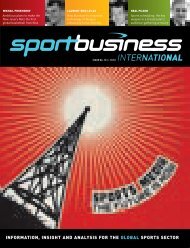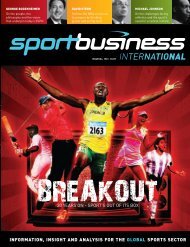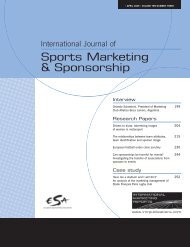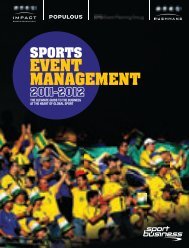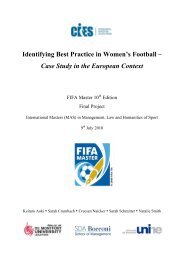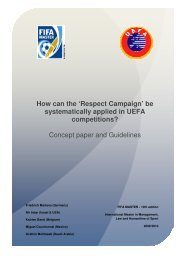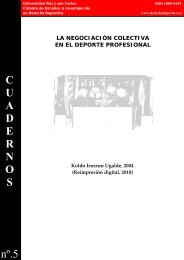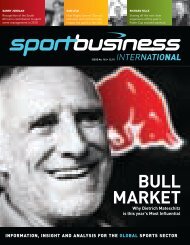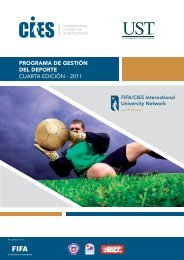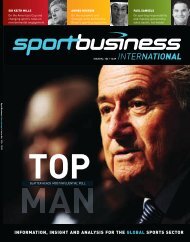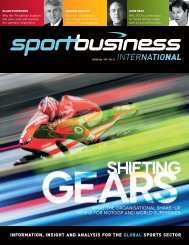Sports Marketing & Sponsorship - FIFA/CIES International University ...
Sports Marketing & Sponsorship - FIFA/CIES International University ...
Sports Marketing & Sponsorship - FIFA/CIES International University ...
- No tags were found...
Create successful ePaper yourself
Turn your PDF publications into a flip-book with our unique Google optimized e-Paper software.
Is motorsport “a race out of place”?any activity is given priority in a city’s public spaces,this indicates that this activity is an acknowledgedand valued part of the local culture.But what happens when these spaces areprivatised, as we have increasingly seen over the pasttwo decades in almost every major city in the affluentworld (Cybriwski, 1999)? One important consequenceis that these public spaces become promotionalvehicles for the profit-making interests that dominatethem (Duncan & Duncan, 1988; Ley, 1987, 1988;Lowes, 2002a, p.113), thus promoting privatised,corporate values. This is particularly relevant when acity’s most important public spaces are handed over tothe motorsports industry and its key sponsorshipinterests – the automobile, tobacco and alcoholindustries. These spaces are then imbued with thevalues of conspicuous consumption and theunrelenting promotion of ‘the good life’ (or perhaps‘the goods life’) that the culture of motorsportcelebrates. This ‘naturalises’ such commercial interestsas self-evident, as part of the general ‘common sense’of society and, therefore, as something to be taken forgranted (Lowes, 1999). Promotional messages whichcelebrate ‘life in the fast lane’ – fast cars, hypermasculinity,smoking and drinking – are privileged.Messages that might call attention to the negativeaspects of privatising public spaces are downplayed,marginalised or excluded altogether. Staging majormotorsports events in important public places adds tothe public approval of this sport, and of all itsattendant commercial interests. This has the effect ofadvancing a city culture that favours the consumerover the citizen as the central point of city life.Commodifying public space serves the interests ofhegemonic groups in society, which may not concordwith the values of ensuring a livable environment forfuture generations.While staging major motorsports spectacles in citystreets is seen as an important aspect of imagemakingfor the city involved, it can also be seen as animportant part of the image-making for the sport ofmotor racing. When parks, waterfronts orparliamentary zones are used to play host tomotorsports events and their profoundly commercialapparatus, they confer legitimacy on these spectacles,and by extension, on the messages they disseminate.The dominant activities in urban public spaces are‘read’ by citizens and tourists alike as indicators of thepriorities of that city and its culture. This may have theeffect of elevating commercial interests above othervalues, including protecting the environment andresources for future generations.The specific ways in which these location effectshave influenced the marketing of motorsport will beillustrated in four case studies. Before examining thesecase studies, the research methods for the paper areoutlined.MethodologyThe research for this paper required a focus on tworelated themes. The first concerned motor racingevents and the second concerned special features ofthe places where these events were located.Places can be seen as spaces that have beeninfused with meaning (Tuan, 1974). Major sportingevents reshape spaces into “sportscapes” (Westerbeek& Shilbury, 1999, p.5), sometimes temporarily (as isthe case for motor racing events in urban streetcircuits). The qualitative research approachesemployed here were chosen to identify the meaningsassociated with motor racing in significant publicplaces in Australian cities. These qualitativeapproaches have been identified as providing thecapability “to provide unique insights into the study ofsport and tourism places” (Higham & Hinch, 2006,p.39), by allowing the reading of underlying meanings(Dann, 2005).This paper incorporated a triangulation approachinvolving multiple methods, namely direct observationof motor racing events, the reading of variousmotorsport ‘texts’ and the analysis of publicly availabledocuments relating to particular public places and theplanning and running of motor racing events (NCA,2000, 2002; Parkinson, 2002). The main researchRESEARCH PAPER● OCTOBER 2009 ● <strong>International</strong> Journal of <strong>Sports</strong> <strong>Marketing</strong> & <strong>Sponsorship</strong>65



